What is bone grafting and why get it?
If you are considering an implant, but dental x-rays or CAT scans have shown that you have a thin jawbone due to bone loss, then a bone graft will be necessary. The amount of bone grafted will always be proportional to the number of implants required.
Alternatively, you may wish to consider a bone graft for aesthetic reasons. After losing several teeth, the face and jawline can begin to appear lined and sunken if steps are not taken to replace the missing teeth. A dental implant with the secure foundation of a bone graft will ensure this needless ageing won’t occur.
What causes bone loss?
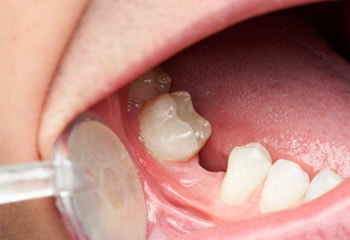 Healthy teeth usually maintain bone density through a natural renewal process ensuring normal bone growth and healthy tooth tissue. However, unhealthy or missing teeth can cause bone loss to occur.
Healthy teeth usually maintain bone density through a natural renewal process ensuring normal bone growth and healthy tooth tissue. However, unhealthy or missing teeth can cause bone loss to occur.
There are many causes of bone loss to the jaw area. Natural ageing can weaken the bone, as can prolonged denture wear, missing teeth, gum disease and infection. Another cause of bone loss is accident or injury, which can lead the area surrounding a missing tooth to recede and the jawbone to shrink.
What types of bone graft are there?
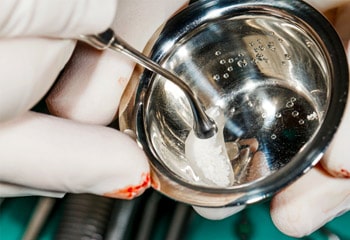 There are four types of bone graft:
There are four types of bone graft:
- Allografts
- Xenografts
- Alloplastic
- Autogenous or Autografts
Allografts
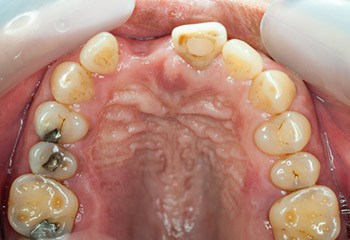 Allografts use natural bone from a human donor, as opposed to bone from another part of your own body. This donation is provided by a dedicated bone bank, which operates in a similar way to a blood bank. Bone samples are sourced from human donors, then rigorously checked and sterilised before being used for grafting. As your body accepts the donor bone, it will merge naturally into your own jaw.
Allografts use natural bone from a human donor, as opposed to bone from another part of your own body. This donation is provided by a dedicated bone bank, which operates in a similar way to a blood bank. Bone samples are sourced from human donors, then rigorously checked and sterilised before being used for grafting. As your body accepts the donor bone, it will merge naturally into your own jaw.
Xenografts
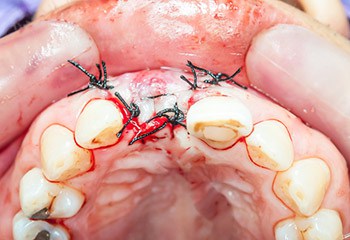 Xenografts are similar to allografts, except the bone donation is from an animal source. The standard source of bone for a xenograft is bovine (from cows).
Xenografts are similar to allografts, except the bone donation is from an animal source. The standard source of bone for a xenograft is bovine (from cows).
Some patients may feel uncomfortable about this form of bone donation, however, there is no need to be concerned regarding safety aspects, as the donation will undergo a system of rigorous testing beforehand. Testing will ensure that the bone sample is completely sterile and compatible with your body and bone composition.
This form of bone graft will stimulate a natural bodily response called ‘Osteoinduction’. Over time, your body will form new bone of its own to replace the grafted bone, using a specific protein called Bone Morphogenic Protein (BMP).
Alloplastic
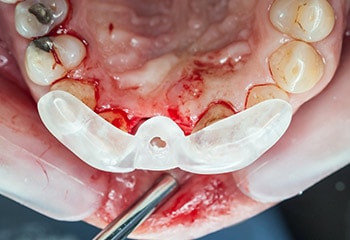 Alloplastic grafts are unique, as they are man-made and do not require the use of natural bone donations. The graft is a synthetic alternative to bone, made from calcium phosphate and practically identical in appearance.
Alloplastic grafts are unique, as they are man-made and do not require the use of natural bone donations. The graft is a synthetic alternative to bone, made from calcium phosphate and practically identical in appearance.
There are two types of alloplastic grafts available: resorbable and nonresorbable. A resorbable graft will gradually be replaced with your own body’s natural bone, while a nonresorbable graft will remain in tact. In both cases, the synthetic graft will provide a structure onto which implants can then be fitted.
Autogenous
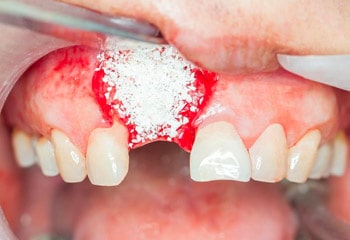 Autogenous grafts are created from a bone sample taken from another area of your own body. The ideal donor spot is the hip bone, as this contains a high level of marrow, which provides plenty of bone cells. The donated cells are then grafted onto the jawbone.
Autogenous grafts are created from a bone sample taken from another area of your own body. The ideal donor spot is the hip bone, as this contains a high level of marrow, which provides plenty of bone cells. The donated cells are then grafted onto the jawbone.
This form of grafting is the most successful technique, although it is only used in cases where the patient has lost a substantial portion of their jawbone, as it is complex and requires surgery to extract the donor cells in addition to the bone graft itself.
Whatever the right choice of bone graft, the treatment is effective and successful and can help you regrow lost bone. Once the bone is strong enough, we can then work on restoring your smile.
How successful are bone grafts?
 Bone grafting is a very successful procedure, although – as with any procedure – there is a small risk of rejection. There is no definite answer as to why rejection sometimes occurs, but factors such as smoking and certain medical conditions can contribute to this risk.
Bone grafting is a very successful procedure, although – as with any procedure – there is a small risk of rejection. There is no definite answer as to why rejection sometimes occurs, but factors such as smoking and certain medical conditions can contribute to this risk.
If your bone graft does fail, the rejected graft will be removed and the area will need to heal before another graft can take place.
If bone grafts are not an option, there are alternative techniques available which can help with the issue of bone loss, such as sinus lifts (or elevations), ridge expansions and distraction osteogenesis. To discuss all your options and plan the best course of action, please book an appointment with our treatment coordinator or call now on 01 454 2022.
What is a barrier membrane?
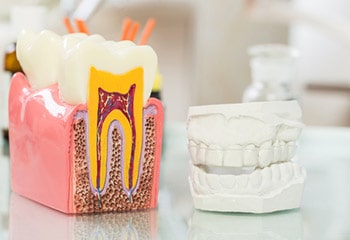 Once the bone graft is in place and the healing process has begun, three types of cell will start to generate: connective tissue cells, epithelial cells and existing bone cells. These cells will compete to fill the area of bone loss where the graft has been placed.
Once the bone graft is in place and the healing process has begun, three types of cell will start to generate: connective tissue cells, epithelial cells and existing bone cells. These cells will compete to fill the area of bone loss where the graft has been placed.
The bone cells would normally lose this battle, but a thin strip of collagen called a ‘barrier membrane’ prevents the epithelial and connective tissue cells from entering the bone graft, allowing your body’s own bone cells to regenerate in peace.
There are two types of barrier membrane: resorbable and nonresorbable.
Originally, barrier membranes were only nonresorbable and worked effectively for many years before the resorbable type was developed. We typically use resorbable collagen membranes for our bone grafting procedures.
Are there any disadvantages?
 Bone grafting is a highly successful and predictable technique which enables your dentist to fit an implant in an area where this might not otherwise have been possible. There are no notable disadvantages, although if you require extensive bone grafting, this may increase your overall treatment time.
Bone grafting is a highly successful and predictable technique which enables your dentist to fit an implant in an area where this might not otherwise have been possible. There are no notable disadvantages, although if you require extensive bone grafting, this may increase your overall treatment time.
If you’d like to know more about any of our treatment techniques or arrange to fit your dental implants at our Dublin clinic, please get in touch.
What People Are Saying
It must be the best dental clinic in the country.
It’s at least the best I’ve ever visited. Got a Crown done, it was made in the clinic they use the most advanced technology I’ve ever seen.
From 3D scanners and programs to a mill that just makes the tooth in like 10 minutes. The staff are extremely friendly and ready to help answer any questions that you might have.
Honestly I’d give more stars but they only let me do 5.
I felt really looked after in all my dealings with this clinic, they’ve really gone above and beyond to provide the best care and clearest information. I especially appreciated the way Anne-Marie, the treatment co-ordinator, guided me through the process.
I would recommend the Portobello Dental Clinic because I felt the price was reasonable, the service was excellent, all the staff were incredibly friendly and helpful and the end result looked great.
I am so glad I found the Portobello Dental Clinic and have no hesitation in recommending them to my family and friends. Everyone at the Portobello clinic is professional and friendly and the follow up phone call after treatment, to inquire how I was feeling was much appreciated.
I recently got implants at Portobello. I am very satisfied with the results and I have confidence that if any problems do arise, that they will be dealt with. I have been going to Portobello for about nine years.
Want to get dental implants but unsure what pre-treatment you may need? Call our Dublin dental clinic for a free consultation on 01 454 2022
